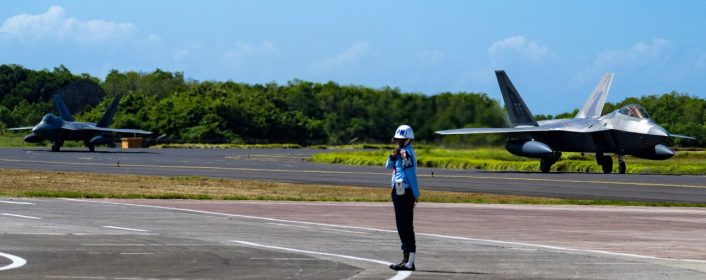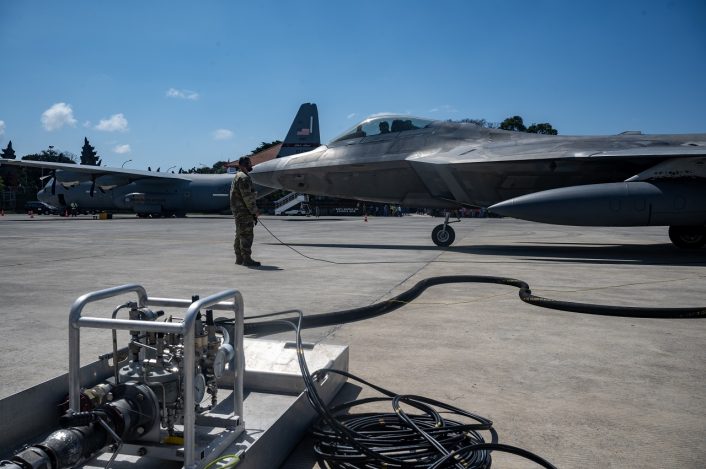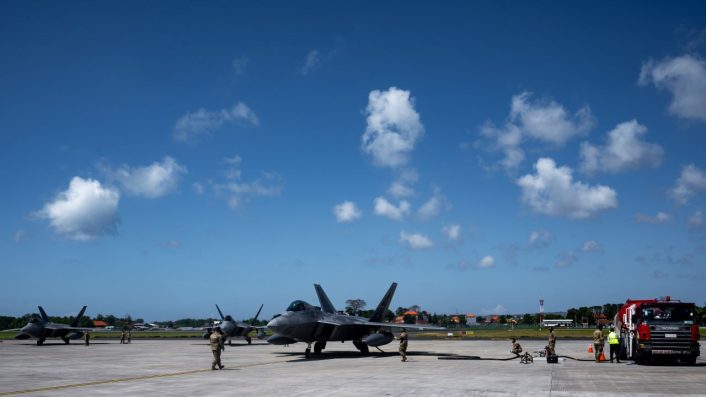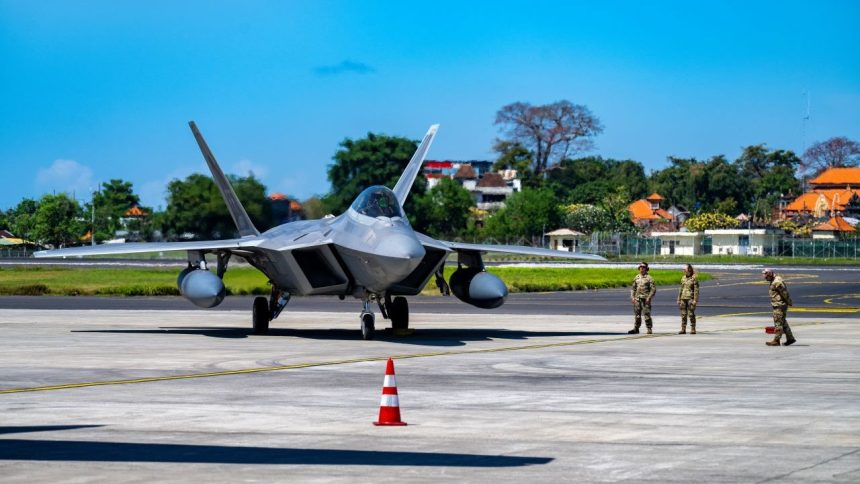The four F-22 Raptors, preceded by a C-130, performed hot-pit refueling operations before departing again, improving the interoperability with Indonesia and increasing the awareness of Indonesian airspace operations.
Four U.S. Air Force F-22 Raptors landed at Indonesia’s I Gusti Ngurah Rai Air Force Base (the military part of BaliInternational Airport) on Aug. 6, 2024, marking the first time U.S. fifth-generation aircraft have landed in Indonesia. The fighters, assigned to the 27th Expeditionary Fighter Squadron from Joint Base Langley-Eustis, Virginia, were part of a Dynamic Force Employment exercise.
The drills were already announced by the Indonesian Air Force (Tentara Nasional Indonesia-Angkatan Udara TNI-AU) in June, after the positive outcome of the site survey by U.S. personnel. At the time, the TNI-AU said that six Raptors were expected to land in Bali for an hot-pit refueling after their participation in Exercise Pitch Black 2024 in Australia.
“Through bilateral training, the U.S. and Indonesian Air Forces work together to promote interoperability, thus furthering our investments and strengthening our relationships,” said the U.S. Air Force. “The relationships and interoperability developed and maintained between the Pacific Air Force and Indonesia through exercises, civilian-military operations, and military exchanges contributes to the preservation of peace and stability in the region.”
Pictures released by the USAF show the four F-22s coming in to land at the base, before taxing to a ramp where all the equipment for the hot-pit refueling was set up. This equipment arrived the day before on an Air National Guard C-130J, and was used to pump the fuel from the airport’s fuel trucks to the waiting Raptors.
The U.S. Embassy in Indonesia said the planned visit allowed pilots and maintenance teams the opportunity to increase awareness of Indonesian airspace operations, in addition to testing rapid refueling capabilities. It has not been specified if the two air forces also performed joint air operations during the visit, since the TNI-AU called the event “Iron Blade Fighter Interaction” when it was announced.
U.S. Embassy press release 🇮🇩🇺🇸:
Four F-22s from the 27th Expeditionary Fighter Squadron landed at I Gusti Ngurah Rai AFB in Bali earlier today under Dynamic Force Employment operations
The Raptors performed hot pit refuelling from an 🇺🇸 C-130 that arrived yesterday https://t.co/A47xIQU8Yu pic.twitter.com/CyLc042C6U
— JATOSINT (@Jatosint) August 6, 2024
Hot Pit refueling
Hot-pit refueling operations are becoming quite routine for U.S. Air Force assets, often performed as part of Agile Combat Employment operations. The hot-pit refueling allows aircraft to rapidly refuel without powering down their engines, which increases operational readiness and reduces the amount of time needed to get the aircraft back into action.
The minimization of the time on the ground during the hot-pit refueling also reduces the vulnerability of the aircraft. This is central to the Air Force’s need to improve the survivability in response to growing threats from rapidly developing technology, which cause an increased vulnerability of bases.
Petroleum, oil and lubricants technicians assigned to the 27th Fighter Generation Squadron were in charge of the preparation of the equipment, tests on fuel and the refueling itself. Indonesian personnel were assigned to the security around the perimeter, the fuel trucks’ handling and the fire services.
An Indonesian C-130 could also be seen in the background while a hot pit was being undertaken, although it was not part of the exercise. As we already mentioned, it’s unclear at the moment whether the F-22s also undertook exercises with TNI-AU aircraft to aid platforms and communication familiarization.
In occasion of the site survey, activities include Fighter Logistic Subject Matter Expert Exchange (SMEE) involving pilots and technicians of Air Squadron 3 from Iswahjudi Air Base and Air Squadron 16 from Roesmin Nurjadin Air Base, both F-16 units. The TNI-AU said pilots and technicians gained experience and knowledge from PACAF personnel on the preparation of expeditionary missions and the rapid deployment to operational areas.

Dynamic Force Employment
The Dynamic Force Employment (DFE) is the new strategy that combines strategic unpredictability with operational adaptability, first introduced by the 2018 National Defense Strategy. The key concept is to be operationally unpredictable in order to disrupt an adversary’s ability to respond and target allied forces.
An application of this strategy are the Bomber Task Force missions, during which the service also describes DFE as the “ability to reach out from home station, fly anywhere in the world and execute those missions, rapidly regenerate from a forward operating base and continue operations.”
This specific definition was given in context of a Jul. 8, 2020 drill where a B-52 Stratofortress from the 96th Bomb Squadron, 2nd Bomb Wing, took off from its home base at Barksdale AFB in Louisiana and participated in a maritime integration exercise with the USS Nimitz and USS Ronald Reagan CSGs (Carrier Strike Groups) in the SCS (South China Sea), before landing at Andersen AFB on Guam.
The B-52 flew the 28-hour mission to demonstrate U.S. Indo-Pacific Command’s commitment to the security and stability of the Indo-Pacific region. “Bomber Task Force demonstrates U.S. capability to rapidly deploy to a forward operating base and execute long-range strike missions,” said on that occasion Lt. Col. Christopher Duff, then 96th Bomb Squadron commander. “The missions support the National Defense Strategy’s objectives of strategic predictability and operational unpredictability.”

The term Dynamic Force Employment is usually adopted by the U.S. military as a whole, while the U.S. Air Force often refers to Agile Combat Employment (ACE) for its operations. However, the two are not necessarily distinct from each other.
In fact, during a DFE exercise which saw Hawaii’s F-22s deploy to MCAS Iwakuni, Japan, the service mentioned that “DFE operations fall under the scope of Agile Combat Employment capabilities which allows Pacific Air Forces to continuously exercise ways to improve passive and active defense capabilities to ensure a competitive advantage and to protect assets and personnel in the future.”
Specifically, the Agile Combat Employment has been defined by the Air Force in its doctrine as “a proactive and reactive operational scheme of maneuver executed within threat timelines to increase resiliency and survivability while generating combat power.” The service also added that agile here means being “able to outpace adversary action through movement and maneuver to achieve commander’s intent.”
ACE essentially involves operating from austere airfields, large roads and highways with little supporting and technical infrastructure, dispersing assets out from the larger air bases that are likely to come under a sudden volume of Russian or Chinese tactical ballistic and cruise missiles. The strategy, while complicating adversary planning, also allows to hold adversary targets at risk from multiple locations.
DFE is thus not necessarily separate from ACE, although we saw a preponderance of the U.S. of the term ACE during Air Force-only exercises or from austere locations, while DFE is seen used during joint operations or from more prepared military facilities at forward locations. In both cases there is the element of the quick movement of forces, and the ability to operate soon after reaching the deployed location.










